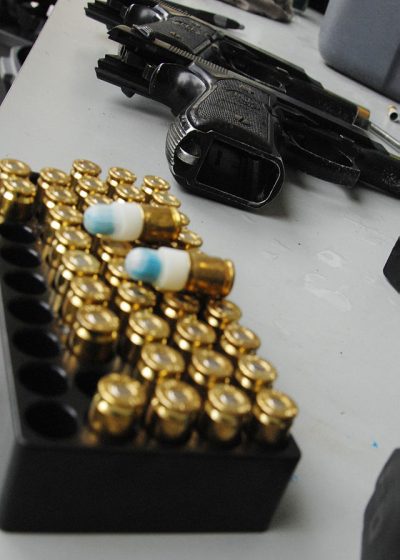A Beginner’s Guide to Force on Force: Part 1
Jordan J. 12.16.21
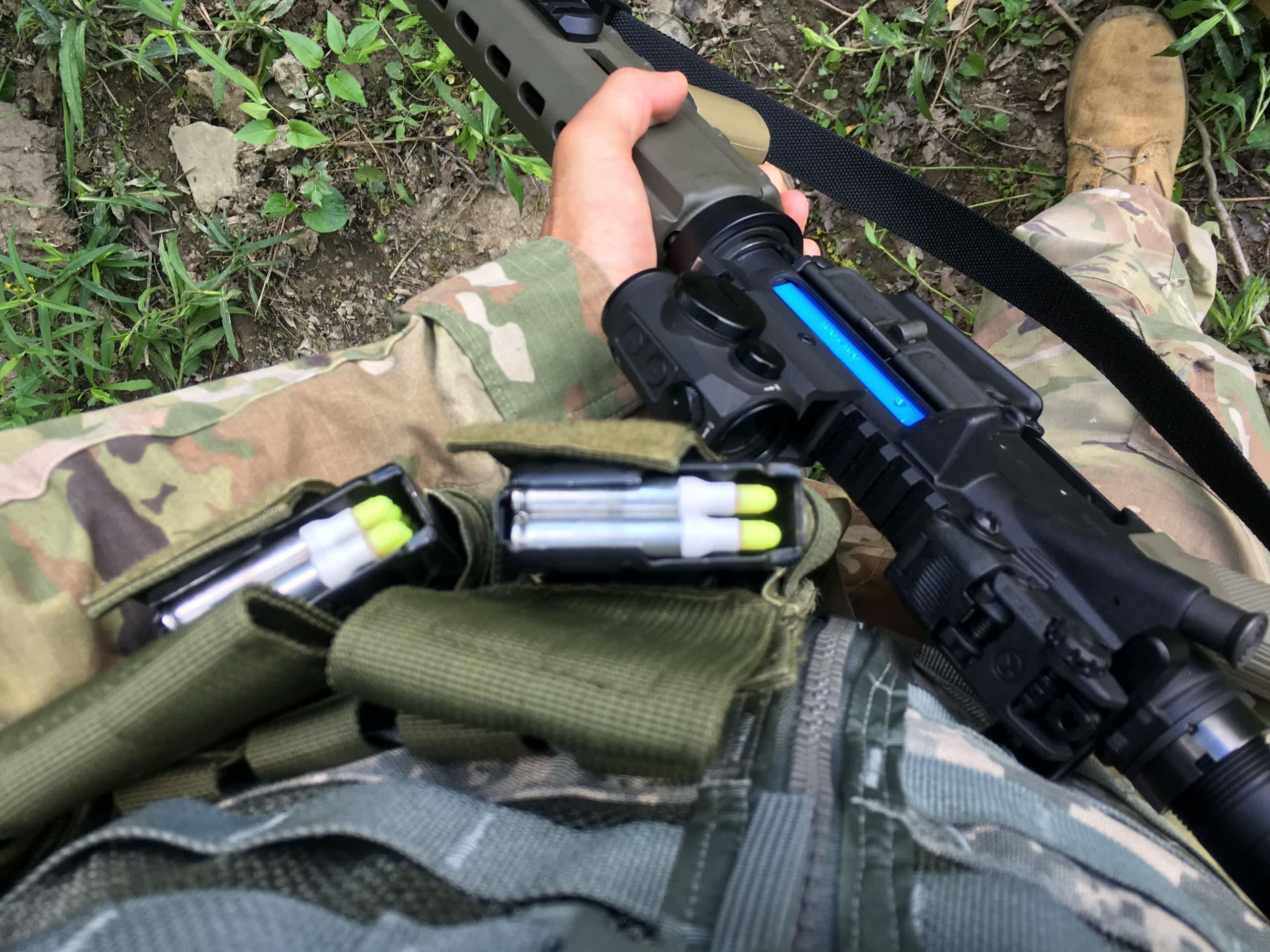
Put your training and weapon skills to the test
You’ve spent hours at the range practicing your marksmanship, weapon-handling, holster draw, and the perfect trigger pull. But will this training stay with you when your brain’s amygdala engages in a real “fight or flight” situation? Thankfully, most of us will never know for sure. But if you want to take your training to the next level and see how you perform under pressure, “Force on Force” should be the next goal on your training to-do list.
“Force on Force” is the broad term for a gamut of training and recreational activities involving you and one or more partners trading gunfire with simulated weapons.
Force on Force (FoF) as it exists today has its roots in both law enforcement/military training, and also in the popular sports of airsoft and paintball that began in the 1960’s-70’s. Today, the gear and equipment previously only accessible to law enforcement and the military is now commercially available to civilians. Additionally, airsoft and paintball gun platforms have evolved to the point where some of these are just as effective and high-fidelity as dedicated training weapons.
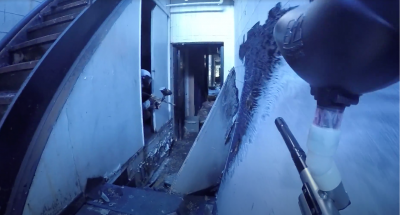
With all this gear currently available, FoF can be a great way for gun owners, concealed carry permit holders, and anyone interested in the tactics of close quarters battled (CQB) to put their theories and skills to the test. Force on Force can:
- Radically open your eyes about your own personal psychological response to danger and your base skill level when operating under the effects of adrenaline
- Allow you to practice familiar shooting and weapon handling skills under pressure in a simulated combat environment
- Be a ton of fun, and a great recreational sport
- Leave you with spectacular bruises and welts that’ll remind you of valuable lessons learned for days after training
Force on Force is also a great shooting activity to pursue during times (such as 2020) when regular ammunition is scarce or limited. Simulated training rounds experienced similar demands and shortages as regular ammunition, but the airsoft and paintball markets stayed relatively flat, price-wise. Unlike real guns, the demand for airsoft and paintball guns never exceeded supply — even during the height of the 2020 COVID market panic, you could still find plenty of airsoft and paintball gear online. Besides, what better time to practice your self defense and combat skills then during a global crisis?
If any of this sounds interesting, keep reading!
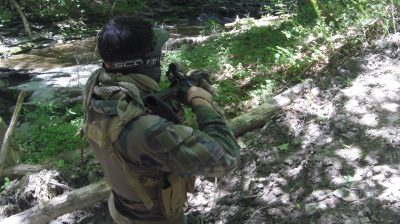
What do you need for FoF and how does it work?
In this series, we’ll provide an overview of all the commercially available gear for FoF. We’ll look at the pros and cons of different weapon platforms and munitions, and the comparative advantages of each. Then we’ll talk about how to successfully run and participate in a FoF event for training or fun.
But first, safety.
The essential safety rules for FoF:
- Even though you’re using a non-lethal training weapon, still DO follow the five golden rules of gun safety: 1) Treat every gun as if it were loaded, 2) Point every gun in a safe direction, 3) Keep your finger off the trigger until you’re ready to shoot, 4) Be sure of your target and beyond, and 5) Only point your gun at something you intend to shoot
- Safety is everyone’s priority — don’t play and train with people who aren’t committed to safety, and make sure you prioritize an injury-free experience
- Don’t let real and simulated weapons and ammunition mix. Because FoF weapons closely resembled real firearms, it is absolutely essential that all real weapons and ammunition stay outside of the FoF area. Establish a sanitized “green zone” where only simulated weapons are allowed inside. Ensure that all real guns and live ammunition are kept outside of this area
- Blue means safe. In the FoF world, magazines, conversion bolts, and weapons themselves are painted or marked with “deep electric blue” to designate them as training weapons
- Everyone should have full face protection at all times – preferably a paintball mask made by a reputable brand. Masks should be on and in place at all times during the activity until the “all clear” is sounded
- Be careful of bystanders and surrounding areas; don’t play and train where an overshot could impact nonparticipants
- Follow and be mindful of all other common-sense safety precautions and your local laws
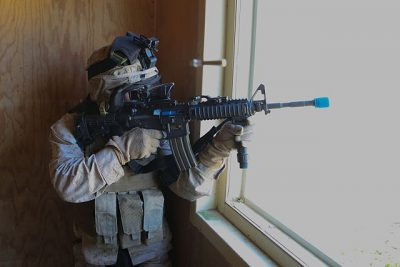
So, What’s the big deal?
You might be wondering, what’s the difference between Force on Force and just playing a regular airsoft or paintball game? The answer is: commitment to realism.
When you go to a paintball park or an airsoft arena, the venue operators aren’t concerned about whether you learn valuable gunfighting skills — they just want you to pay money for a safe and fun time. Similarly, many of the participants aren’t there to practice good military tactics; they came for the competitive rush of running around and shooting stuff. It’s hard to quite put it into words, but there’s something about public paintball parks that breaks the “suspension of disbelief” and reminds you that you’re not in a real war theatre.
That being said, if you’ve ever gotten together with a bunch of friends and tried to play a truly combat-realistic airsoft or paintball game — congratulations! You’ve already done FoF. Not quite sure how to make it realistic? Here are three rules for realism that, if followed, can transform even a pickup paintball game into an exciting and valuable FoF experience:
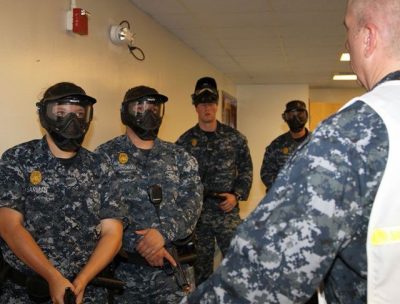
Rules for Realism #1: Don’t confuse concealment for cover
In Law enforcement/Military FoF training, it’s common practice to substitute doors and walls with sheets of butcher paper that can be replaced between scenarios. Since any sim round will go through paper, students are encouraged to shoot through these obstacles to hit opponents hiding on the other side.
When you set up a FoF scenario, you’ll encounter lots of concealment that will effectively stop a sim round, but would provide no protection in real life. This can include brush, bushes, windows, drywall (if you’re lucky enough to find an indoor area to train), plywood sheets, oil drums, etc. You need to discipline yourself not to rely on these barriers for protection. If you find yourself behind a flimsy barricade with paint rounds smacking the other side — you need to consider yourself hit and recognize that you’d be a casualty in real life. You won’t be doing yourself any favors if you pride yourself on surviving when the only thing that saved you was the weak penetrating power of a simulated weapon.
Similarly, if you’re engaging an opponent and they duck behind thin concealment, you should respond differently in FoF than you would in a regular paintball game. Check out the fuzzy helmet-cam action still below:
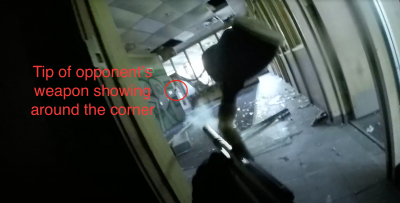
In this picture, the viewer is engaging an opponent who’s hiding behind the far corner. You can just barely see the tip of the opponent’s weapon. Now, in a paintball game, you would either wait for the opponent to reveal themselves, or MAYBE try to hit the tip of their gun (some paintball players will call themselves out on a weapon hit, other’s won’t).
But, if you’re training in FoF, you’re going to do something differently — you are absolutely going to put a few rounds into the side of the wall your opponent is hiding behind. Why? Because in a real life situation, that drywall/stick-framed corner provides your opponent with zero ballistic protection. You want to train yourself to shoot through enemy barricades and neutralize the threat.
A 5.556 round will go through a lot of things — doors, walls, most parts of a car, barrels, plywood. Therefore, you should train yourself to shoot through these things. Now, will your opponent react and consider themselves hit when they hear your paintballs smacking ineffectually against the wall? Probably not — but this training is for you, not for them. You’re not trying to ‘win’ a ‘game’ here — you’re doing everything you can to build the correct muscle memory and combat habits. This is the main point of:
Rules for Realism #2: Be an actor, not a gamer
What’s the main rule of airsoft and paintball? If you get hit, stand up, raise your hands, go to the re-spawn point. Anything else is cheating, right? This is not necessarily true or helpful in Force on Force. Think about it: if you’re in an actual combat situation and you strike the enemy, are they going to stand up and raise their hands? Probably not. Likewise, if you’re ever in a combat situation, and, God-forbid, you are struck by a bullet, are you going to stand up and say “you got me, guys?” I hope not.
With the goal of making FoF as close to real life as possible, I believe participants should have a different response when they are hit — something more realistic. A FoF participant should do two things when they’re hit:
- Provide audible and visual feedback to their opponent simulating a neutralized or temporarily neutralized threat, and
- Roleplay how they would respond if they were hit
What does this look like? It can be as simple as letting out an exclamation of pain and recoiling to let your opponent know they got you. In some training activities I’ve attended, participants were required to carry a first aid kit with them (gauze, tourniquet, sponges). If hit, they had to seek cover and perform simulated first aid on themselves while continuing to engage in the combat scenario. This seems much more realistic and valuable than the standard “stand up, tag out, re-spawn” response. Imagine lying on the ground, trying to put a tourniquet on your leg with one hand while maintaining control of your weapon with the other hand and tracking incoming opponents at the same time. Why NOT use this as an opportunity to practice your first aid skills under pressure as well? It makes sense, and is much more valuable than simply re-spawning when hit.
If you sustain a simulated headshot or other injury where first aid would not be effectual or plausible, it’s a lot more educational to surviving players to take a theatrical dive and do your best Hollywood representation of a casualty. By ‘acting out’ you make everything more realistic for the other participants still in the scenario.
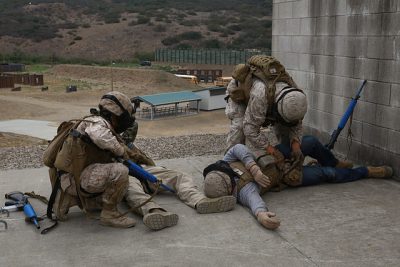
So, how do you decide who “won” the engagement? Unlike a paintball game, that’s not the goal of FoF. The goal is for everyone to learn something. After the completion of a scenario, I recommend holding a quick ‘debrief’ before the next round for everyone to honestly compare notes about how the scenario would have gone in real life. It’s very common to have a “winner” who reveals that in a real-life situation, they wouldn’t have made it — perhaps they were only saved from a fatal shot by a window, or the branch of a tree. Many times, I’ve technically ‘won’ a FoF match, but still considered myself a casualty since only some simulation-environment factor saved me.
The goal of FoF should never be to ‘win’, but rather to use the scenario to hypothesize how a real-life encounter would go, and immerse yourself into the scenario as an actor. Maintaining realism and “suspension of disbelief” is every participant’s job.

Rules for Realism #3: Only orchestrate close-range scenarios
This last one is self-explanatory: if you and your opponent can see each other, but can’t hit each other, you’re too far away. Nothing screams “Fake!” like two guys lobbing paintballs at each other from 60 yards away, hoping for a lucky hit.
Generally, most FoF training weapons have an effective range of 30 yards due to the low FPS of training projectiles. Within 30 yards, sim weapons enable you to effectively aim and shoot with realistic accuracy, but once you spread out further, accuracy (and realism) wane exponentially. Therefore, I recommended establishing a boundary in which all the FoF activity occurs, and keeping engagements limited to 30 yards or less.
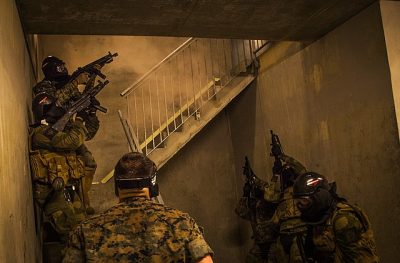
The Gear you need for Force on Force
After making sure you have a full-face paintball mask from a reputable brand, the next important step is deciding what type of simulated weapon you want to use. There are literally hundreds of options, but we can generally divide FoF weapons into three categories:
- Guns that shoot paintballs
- Guns that shoot airsoft pellets
- Guns that shoot specially made simulated ammunition.
In the next part of this series, we’ll delve into the virtual armory of all the possible types of guns and ammunition you can use to play FoF and share the pros and cons of each weapon type.

